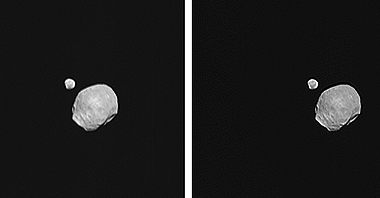The European Mars Express spacecraft captured a rare transit of two Mars moons in the camera's frame and returned to Earth high-resolution images of a transit that had only been captured once so far from the ground-based Spirit vehicle at low resolution about 4 years ago
By Nancy Atkinson

The European Mars Orbiter Mars Express last month captured images of the conjunction of two Martian moons, Phobos and Deimos. This is the first time that the moons have been photographed together in high resolution, although it is not the first time that they have been photographed together at all - the Spirit rover photographed them from the ground passing over it together in 2005, but the new images provide a sense of 'wow' and help improve the models of the orbits of the two moons of Mars in particular and two moons together in general.
"It doesn't happen often that the two moons of Mars are right in front of the camera, directly behind each other," said Hoffman Harald of the German Space Center (DLR) working on the Mars Express project. "During the six-year project, we had several opportunities to photograph the two moons together," said Klaus Dieter Metz, who worked with Hoffmann to plan the shooting of these images. "The geometry of the system during lap #7492 of the Mars Express on November 5, 2009 was particularly positive, so this time we wanted to try to snap a sequence of images - and the first attempt provided the hoped-for result."

Phobos, the larger of the two moons, moves in a close orbit to the red planet and orbits it every 7 hours and 39 minutes. It moves faster relative to Mars than the Moon moves relative to Earth. It was at the time of the photograph at a distance of 11,800 km from the spacecraft. Dimus was then 26,6200 km away from her.
The images were captured using the ultra-high-resolution channel (SRC) in the high-definition stereoscopic camera (HRSC). The camera took 130 images of the moons at 09:14 CET on November 5, over a minute and a half at one-second intervals and sped up to half-second intervals towards the end. The photo resolution is 110 meters per pixel for Phobos and 240 meters per pixel for Deimos - because, as mentioned, Deimos was more than twice as far from the camera compared to Phobos.

7 תגובות
Why doesn't NASA direct the billions to more essential things that can contribute to humanity much more - such as settling on the moon for long-term research regarding life in space, exploiting resources in space, producing water and energy in space, developing living solutions in space and much more.
I have an uncomfortable feeling that instead of all the important things I mentioned, NASA is dealing with nonsense and public relations.
aviku how did you make your name bold? Can you explain the trick to me?
And why are the fonts on this page so minimized?
Really gives a feeling of "wow".
Spending billions to wow.
Did you see how he overtook him in the turn?? Just like space car racing!
the European Mars Express spacecraft,
German Space Center (DLR),
European money.
Neither NASA nor American money...
The wow effect is found in human curiosity, which knows no bounds.
"The new photos provide a feeling of 'wow'..."?
Hush, my beating heart!
Two small, gray rocks that accidentally got caught in orbit around Mars and passed each other are a reason for so much excitement and such a superlative title?
Doesn't NASA have better things to do with the American public's money?
Lots of fuss about nothing.